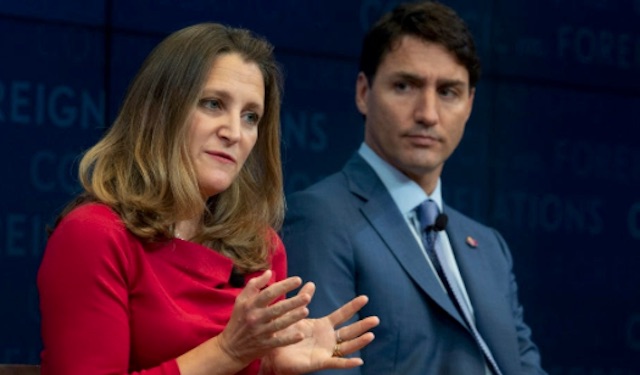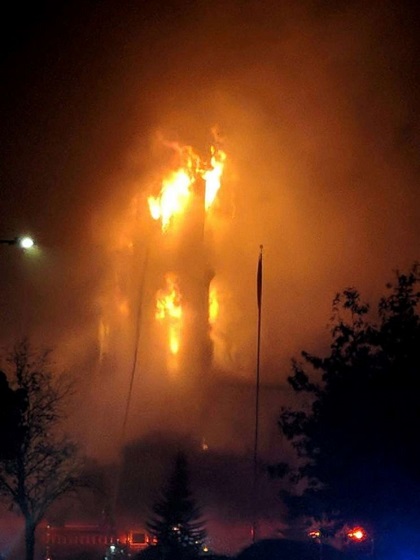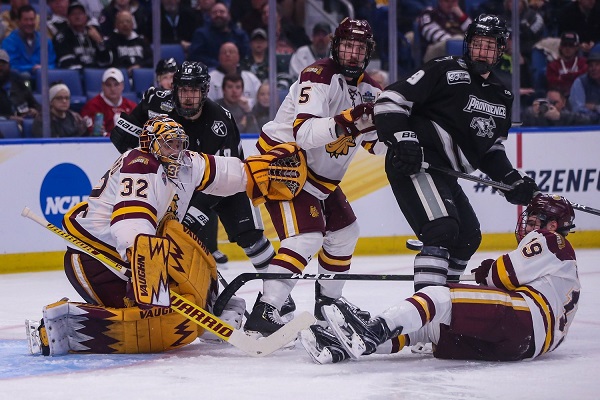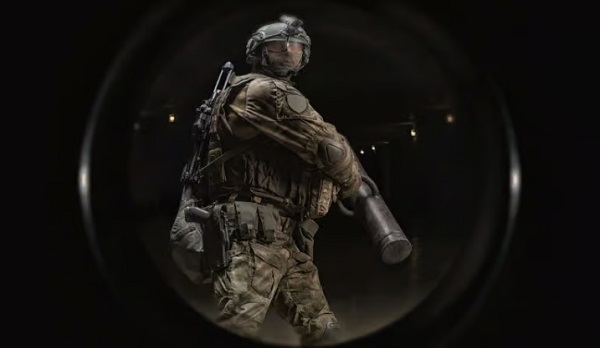Opinion
Bank of Canada’s Band-Aid on a Bullet Wound

This article is from The Opposition With Dan Knight substack. |
|
The Hidden Tax of Trudeau’s Policies: Why Canadians Can’t Afford to Ignore the Real Culprits Behind Inflation and Economic Woes
Good morning, Canada. If you paid attention to yesterday’s announcement from the Bank of Canada, you’ll know they maintained their policy rate at 5% while continuing their quantitative tightening. But what you may not realize is how this is really just putting a band-aid on a bullet wound—a wound inflicted largely by the policies of our Prime Minister, Justin Trudeau.
Firstly, let’s talk about inflation. This is not just an abstract concept or economic jargon; it’s a tax—a silent, insidious tax that drains your income, reduces your purchasing power, and makes your life more expensive. The Bank of Canada admits that inflationary pressures remain broad-based, and that’s no surprise when Trudeau’s administration is running up deficits in the billions. His fiscal irresponsibility is supercharging inflation, and it’s Canadians like you and me who are paying the price.
But Trudeau’s policies don’t just stop at fiscal mismanagement; they’re also significantly impacting the housing market. Trudeau’s indiscriminate approach to immigration is driving up demand for housing, while doing little to increase supply. What we end up with are skyrocketing home prices, which are pushing the dream of homeownership further away for everyday Canadians. The recent economic data confirms this grim reality; the Canadian economy contracted at an annualized rate of 0.2%, yet housing prices are inflated beyond reason.
Now let’s talk about the carbon tax. This is a policy that has done nothing but raise the cost of living for Canadians across the board. Whether you’re filling up your car, heating your home, or buying groceries, Trudeau’s carbon tax makes everything more expensive. Even the Bank of Canada’s report highlights the impact of recent increases in gasoline prices on consumer price inflation. It’s absurdly hypocritical that while Trudeau preaches about justice and equality, he’s willing to burden Canadians with policies that make life unaffordable for many.
So, when the Bank of Canada says it’s holding its policy rate steady at 5% and continuing to normalize its balance sheet, don’t be fooled. These are not solutions; they’re temporary measures that might alleviate some of the symptoms but do nothing to treat the cause. Trudeau’s reckless deficit spending, his flawed immigration policy, and his ideologically driven carbon tax are the real driving factors behind our nation’s financial malaise. And no amount of “quantitative tightening” by the Bank can remedy the damage done by these policies.
In the end, it’s accountability that we need. While the Bank of Canada may be committed to restoring price stability, let’s not forget that the root cause of our economic instability lies squarely with Trudeau’s leadership. His financial recklessness is making life increasingly difficult for average Canadians, inflating everything from the cost of a loaf of bread to mortgage payments. The time for a course correction is now, and it starts by acknowledging the true source of our problems. This is the story you won’t hear in the mainstream media, but it’s one that all Canadians need to understand. This is Dan Knight, signing off from Vancouver. Stay vigilant, Canada.
#cdnpoli
Invite your friends and earn rewards
Click here to see more from The Opposition with Dan Knight.
For the full experience, upgrade your subscription.
Frontier Centre for Public Policy
It’s Time To Stop Church Arsons And What Fuels Them

From the Frontier Centre for Public Policy
By Lee Harding
Religious freedoms and the right to worship have been a recognized hallmark of civilized societies for centuries. The preamble of Canada’s constitution says our country is built on the principles that acknowledge the supremacy of God and the rule of law. In defiance of both, almost 600 Canadian places of worship have suffered arson in recent years. Nothing could be more unCanadian.
The stats were revealed by Member of Parliament Marc Dalton following a formal inquiry to the federal government. The response showed 592 arsons had been set on places of worship between 2010 and 2022. they rose from 58 in 2020 to 90 in 2021, then down to 74 in 2022.
The peak coincides with claims made in May of 2021 that the remains of 215 school children had been discovered on the site of the former Kamloops Residential School.
Although Prime Minister Justin Trudeau called a subsequent wave of church burnings “unacceptable and wrong” he also called their likely motivations “real and fully understandable.” This hardly doused the flames.
These arsons far outnumber those made on Canadian churches in the 1920s by the Ku Klux Klan, which opposed non-Protestants and non-whites. In those years the KKK desecrated Sarnia’s St. Joseph’s Catholic Church. They killed ten people when they set Saint-Boniface College in Winnipeg on fire. They also burned the Cathedral-Basilica of Notre-Dame de Quebec. In 1926, three Klan members were jailed after they blew up St. Mary’s Roman Catholic Church in Barrie, Ont.
The Klan soon fizzled out, seemingly unlike these recent church burnings. The 110-year-old Notre-Dame-des-Sept-Allégresses Catholic church burned down in Trois-Rivières, Quebec last month, but whether arson was involved has not been confirmed.
The presence of bodies underneath the former residential school in Kamloops has not been confirmed either. A 1924 septic field could also account for soil anomalies found there by ground-penetrating radar. Eight million federal tax dollars spent to investigate the site have yielded no remains and details on how the money was spent are sketchy. It’s high time the site was excavated to confirm or rule out the graves and do autopsies on any corpses found there.
Federal funds also fuel the Canadian Anti-Hate Network (CAHN), the Orwellian title for a group that fuels resentment against socially conservative organizations with negative characterizations. On August 7, CAHN published “40 Ways To Fight The Far-Right: Tactics for Community Activists in Canada” thanks to $640,000 from Ottawa.
“White boys and men make up the majority of people involved in hate-promoting movements,” the handbook explains. Pro-life and pro-parent groups, CAHN says, are among those “characterized by racism, antisemitism, Islamophobia, misogyny, anti-2SLGBTQ+ views, and pro-colonialist/ anti-Indigenous bigotry.”
CAHN says the Catholic-dominated, pro-life organization Campaign Life Coalition is a “hate movement.” Liberty Coalition Canada, a legal defence organization, and the activist organization Action4Canada are similarly denigrated for their alleged belief that Canada was founded on Christian values and attempts to reassert such values.
Meanwhile, the CAHN guide advocates “antifascist” doxing, including infiltration of right-leaning organizations. getting people fired, and ending friendships.
Dalton’s Bill C-411 the “Anti-Arson Act” would do more to deter hate-motivated crimes than CAHN ever will. The legislation would punish those who set fires and explosions at religious places. A first offence would get a mandatory five-year jail sentence, while subsequent offenses would prompt seven years.
When respect for the supremacy of God and the rule of law fail, rights give way to wrongs. It’s time to stop the fires and the disputable claims that fuel them, and restore respect for people of faith, their right to worship, and their places of worship.
Lee Harding is a Research Associate for the Frontier Centre for Public Policy.
Bruce Dowbiggin
CHL Vs NCAA: Finally Some Sanity For Hockey Families

In forty-years-plus of covering sports you develop hobby horses. Issues that re-appear continuously over time. In our case, one of those issues has been pro hockey’s development model and the NCAA’s draconian rules for its participants. Which was better, and why couldn’t the sides reach a more reasonable model?
In the case of hockey the NCAA’s ban on any player who played a single game in the Canadian Hockey League created a harsh dilemma for hockey prodigies in Canada and the U.S. Throw your lot in with the CHL, hoping to be drafted by the NHL, or play in a secondary league like the USHL till you were eligible for the NCAA. Prospects in the CHL’s three leagues — the OHL, QMJHL and WHL —were classified as professional by the NCAA because they get $600 a month for living expenses, losing Division I eligibility after 48 hours of training camp. The stipend isn’t considered income for personal tax purposes.”
Over the decades we’ve spoken with many parents and players trying to parse this equation. It was a heartbreaking scene when they gambled on a CHL career that gave them no life skills or education. Or the promised NCAA golden goose never appeared after playing in a lower league for prime development years.
There were tradeoffs. NCAA teams played fewer games, CHL teams played a pro-like schedule. The NCAA awarded scholarships (which could be withdrawn) while the CHL created scholarships for after a career in the league (rules that players getting NHL contracts lost those scholarships has been withdrawn). There were more contrasts.
As we wrote here in 2021, it might have stayed this way but for a tsunami created by the antitrust issue of Name Image Likeness for NCAA players who were not paid for the use of their NIL. When the U.S. Supreme Court ruled on the issue in 2015 it warned the NCAA that its shamateurism scheme had to change. That created revolution in the NCAA. Athletes now receive healthy compensation for their image in video and digital products. They can also take million-dollar compensation from sponsors and boosters.
Portals allow them to skip from team to team to find millions in compensation. One of the many changes in the new NCAA was its prohibition against CHL players. To forestall future lawsuits costing millions, it recently made hockey players eligible for the same revenues as football and basketball players. Now the NCAA has voted to open up college hockey eligibility to CHL players effective Aug. 1, 2025, paving the way for major junior players to participate in the 2025-26 men’s college hockey season.
Which, we wrote in 2022, would leave hockey’s development model vulnerable. “As one insider told us, “The CHL model should be disrupted. Archaic and abusive.” NIL won’t kill the CHL but it could strip away a significant portion of its older stars who choose guaranteed money over long bus rides and billeting with other players. It’s early days, of course, but be prepared for an NHL No. 1 draft pick being a millionaire before his name is even called in the draft.”

As we wrote in May of 2022 “A Connor McDavid could sign an NIL styled contract at 16 years old, play in the NCAA and— rich already— still be drafted No. 1 overall. Yes, college hockey has a lower profile and fewer opportunities for endorsements. Some will want the CHL’s experience. But a McDavid-type player would be a prize catch for an equipment company or a video game manufacturer. Or even as an influencer. All things currently not allowed in the CHL.”
Effectively the CHL will get all or most of the top prospects at ages 16-19. After that age prospects drafted or undrafted can migrate to the NCAA model. Whether they can sign NHL contracts upon drafting and still play in the NCAA is unclear at this moment. (“On the positive side, we will get all the top young players coming to the CHL because we’re the best development option at that age,” one WHL general manager told The Athleltic’s Scott Wheeler.

One OHL GM told the Athletic “As the trend increases with American players looking for guarantees to sign, does a CHL player turn down an opportunity to sign at the end of their 19-year-old year with the hopes that a year at 20 in NCAA as a free agent gives them a better route to the NHL?”
The permutations are endless at the moment. But, at least, players and their families have a choice between hockey and education that was forbidden in the past. Plus, they can make money via NIL to allow them to stay for an extra year of development or education. The CHL will take a hit, but most young Canadian players will still see it as the logical launching pad to the NHL.
Now, for once, families can come first on the cold, nasty climb to the top hockey’s greasy pole.
Bruce Dowbiggin @dowbboy is the editor of Not The Public Broadcaster A two-time winner of the Gemini Award as Canada’s top television sports broadcaster, he’s a regular contributor to Sirius XM Canada Talks Ch. 167. His new book Deal With It: The Trades That Stunned The NHL And Changed hockey is now available on Amazon. Inexact Science: The Six Most Compelling Draft Years In NHL History, his previous book with his son Evan, was voted the seventh-best professional hockey book of all time by bookauthority.org . His 2004 book Money Players was voted sixth best on the same list, and is available via brucedowbigginbooks.ca.
-

 Brownstone Institute10 hours ago
Brownstone Institute10 hours agoThe Most Devastating Report So Far
-

 Economy22 hours ago
Economy22 hours agoCOP 29 leaders demand over a $1 trillion a year in climate reparations from ‘wealthy’ nations. They don’t deserve a nickel.
-

 Censorship Industrial Complex14 hours ago
Censorship Industrial Complex14 hours agoAnother Mass Grave?
-

 Alberta13 hours ago
Alberta13 hours agoMAiD In Alberta: Province surveying Albertans about assisted suicide policies
-

 Alberta20 hours ago
Alberta20 hours agoOn gender, Alberta is following the science
-

 Energy21 hours ago
Energy21 hours agoOttawa’s proposed emission cap lacks any solid scientific or economic rationale
-

 Bruce Dowbiggin9 hours ago
Bruce Dowbiggin9 hours agoCHL Vs NCAA: Finally Some Sanity For Hockey Families
-

 Brownstone Institute2 days ago
Brownstone Institute2 days agoFirst Amendment Blues




